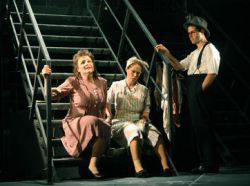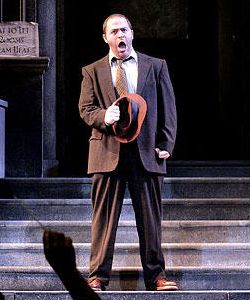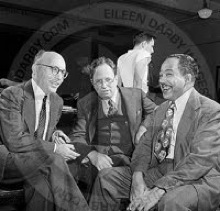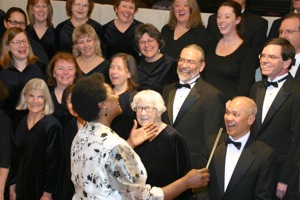
Featured Video
Related Articles
Behind the Mystique: Kurt Weill and 1920s Berlin
March 31, 2009
Oakland East Bay Symphony: Gold at 20
March 3, 2009
Why Kurt Weill and Langston Hughes’ Street Scene (1947) is not regularly performed remains a mystery. Weill’s music for this “American opera” (or “Broadway opera,” as he alternately called it) won the first Tony Award for Best Original Score; its musical mélange of Broadway, jazz, blues, and Puccini-esque idioms is as Broadway-by-way-of-Berlin as anything can get.
Hughes’ libretto for Street Scene, an adaptation of Elmer Rice’s Pulitzer-winning play of the same name, achieves Weill’s goal: to “lift the everyday language of the people into a simple, unsophisticated poetry.” And even in 2011 Rice’s story, which explores the hopes, loves, dreams, illusions, and violence of the inhabitants of a tiny portion of New York’s East Side melting pot, retains all its cultural, political, and spiritual relevance.
Had Bernstein and Sondheim met a decade before the Jets, or Sondheim time-traveled back from Fleet Street, they might well have found themselves on the East Side of New York City, consumed by the Maurrants’ family drama that is central to Street Scene. So wonderful is Weill’s music, and so telling are the poetic rhythms of Hughes’ libretto, that Oakland East Bay Symphony Music Director Michael Morgan is cutting relatively little of the opera for his forthcoming American Masterworks concert version, May 13 at the opulent Paramount Theatre.
“The more you look at the score, the more sensational it gets,” he declares. “It goes from operatic Puccini to dance hall to almost ragtime, depending upon what’s going on. The little children’s game song at the beginning of Act 2 may be intentionally simple, but the fantastic ice cream sextet is a take-off on all those concertatos that happen in every Verdi opera. The rest of the tonal score is very rich, and quite chromatically complex when the characters look inward.”
Morgan is equally excited by the subject matter. “The drama of how different ethnicities raise their children, the neighbors gossiping about what’s going on in various households, the father who longs for this poorly defined past he thinks has slipped away — I thought it all so current to make it worth doing, just for that. The father’s aria about wanting things to be ‘like they always was’ is just like the group of people today who want things to go back to the way they were, even though the way they were not only is not very defined, but for most people was not that great.”
Parallel Lives

The corespondences between the lives of Hughes and Weill, and the common intent that brought them together, are striking. Indeed, after listening to musicologist and Oakland Symphony Chorus Director Lynne Morrow expound on the two men’s individual and collective journeys, it’s tempting to entertain the notion that Weill (1900–1950) and Hughes (1902–1967) were, in some respects, twin souls who came together for the purpose of elevating the lives and struggles of everyday men and women of all races.
Weill, who was born in Dessau, Germany, was the son of a cantor. His family was one of perhaps 200 Jewish families in a town of 15,000. Yet, despite their minority status, Weill’s family traced its lineage back to the 1500s, and was extremely well-connected to the powerful in local society. Young Kurt’s interest in music was as strong as the anti-Semitism he was to confront when, at the end of World War I, he began to study composition at the Hochschule für Musik in Berlin with some of the great German composers of the era.
Hughes, a lad of African-American, European-American, and Native-American descent, was born just two years after Weill, in Joplin, Missouri. His mother was a schoolteacher, his granduncle the first African-American elected to the U.S. Congress from Virginia. Hughes’ maternal grandmother, one of the first women to attend Oberlin College, married a man who fought alongside John Brown at Harper’s Ferry. In short, his family was as educated and culturally sophisticated as Weill’s. “They were scholars, intellectuals, and leaders, not self-haters trying to be white,” says Morrow.
Hughes’ grandmother, who raised him after his parents divorced, helped instill in him a sense of racial consciousness. This was undoubtedly strengthened when he was elected “class poet” in elementary school because the teacher emphasized the importance of rhythm in poetry. As one of only two black children in his class, Hughes was therefore considered one of the two most rhythmically endowed. It was an era of pervasive stereotypes.
“This changed his life,” says Morrow. “The stereotype ended up giving him power.”
Coming of Age

Hughes’ father moved to Cuba, then Mexico, to escape racism. Around the same time, his mother had moved north to try to get a teaching job. After the grandmother who had taken him in died, his mother and stepfather left him in Cleveland to complete high school on his own. Hughes thus found himself extremely isolated at the same that Weill, with the emotional support of his family, was encountering anti-Semitism and writing compositions of such quality as to convince pianist/composer Ferruccio Busoni to accept him as a master student.
After graduating high school, Hughes traveled to Mexico to see his father and ask him for money to attend Columbia University in New York City. When his father instead wanted him to enroll in an engineering school abroad, to avoid racism, Hughes returned to the U.S. and spent a year writing poetry. After some of it was published, Hughes’ father relented and agreed to pay for a year at Columbia. Hughes left the school after that due to racial prejudice.
In 1925, Weill wrote a Concerto for violin and wind orchestra that critics compared to Stravinsky. At about the same time, Hughes was winning first prizes for his poetry and becoming a player in the New York City art scene later dubbed the “Harlem Renaissance.” Both men started to write for the theater at around the same time.
In 1927, Weill met Bertolt Brecht. Together they decided to reform German opera and theater and make it more socially relevant. The fruits of their efforts, The Rise and Fall of the City of Mahagonny (1927) and Threepenny Opera (1928), were two of the biggest hits of 1920s Germany.
Weill first saw the play Street Scene in Germany in 1930. Three years later, after Hitler came to power, Weill was denounced for his progressive views. Wisely, he left for Paris and, in 1935, he moved to the U.S.
As Weill and Maxwell Anderson were writing Knickerbocker Holiday, which concerns itself, allegorically, with fascism, Hughes was in Spain, serving as a war correspondent during the Spanish Civil War. Both he and Weill felt deep concerned about what was happening in the lives of the common people, and in the global political arena. Perhaps the main difference between the two is that Hughes spent his life concealing his homosexuality from the public.
On the Street Where You Live

In 1946, Elmer Rice finally gave in to Weill’s repeated request to allow him to set Street Scene to music. He then suggested Langston Hughes, who by that time was famed as the Harlem Renaissance poet who had most successfully incorporated jazz and blues rhythms into the style of his poetry, as the man most likely suited to assist Weill in fashioning the libretto of his “American opera.”
Given Weill’s goal of creating a new musical theater that would incorporate jazz and other authentic American musics, and would explore social and political topics often considered verboten, Weill and Hughes were a match made in Manhattan. Hughes took Weill to Harlem so he could become better acquainted with the jazz and black music that had helped make New York City so vibrant.
Was Street Scene a departure for Hughes? To Morgan, who notes that the only black character in the opera is a doorman, and that racism is not a central theme, yes. To Morrow, who observes that both Hughes and Weill wished to elevate the lives of everyman/everywoman to the level of art, and that Hughes did write about white people in his collection of short stories, The Ways of White Folk (1934), the answer is no.
Either way, Street Scene served both artists well. It not only won Weill a prestigious Tony, but also gave Hughes the money he needed to finally buy a house and achieve a modicum of financial security.
Weill completed the music for three more works for the stage — a folk opera, Down in the Valley; a vaudeville, Love Life; and a musical tragedy, Lost in the Stars — before suffering a fatal heart attack in 1950. His fourth and final collaboration with Maxwell Anderson, Huckleberry Finn, remains unfinished. Hughes, by contrast, continued to create prolifically, influencing an entire generation of younger writers, including his discovery, Alice Walker.
Who can say whether Weill and Hughes might have collaborated more, had the composer lived longer? All that’s certain is that Oakland East Bay Symphony’s concert adaptation, complete with spoken summaries that will replace some spoken dialogue, will afford a rare opportunity to assess and enjoy the work that Weill considered his masterpiece.
